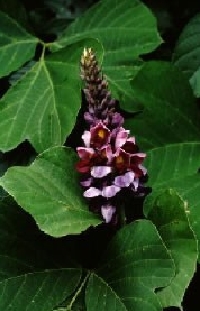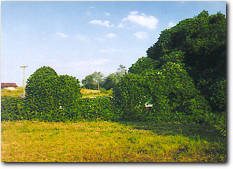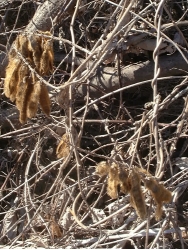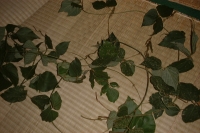what's kudzu

kudzu flower
Kudzu (Vines in Legumes) is everywhere in Japan, including edges of woods and river banks.
Kudzu grows with trmendous momentum in spring and summer, and sometimes it grows 50cm in a day. Kudzu's roots grows so deeply, and it used to reinforce steep slopes of river banks.
Kudzu flour is made from its roots, and used for many Japanese foods. Dried roots of Kudzu are used in herbal medicine, and they can reduce fever ; it's called "kakkonto" in Japanese.
Kudzu flowers come out in the early Autumn with beautiful magenta color ; it resembles wisteria flowers.
It is called "Rising Wisteria" because Kudzu flowers turn upside whereas wisterias flowers turn down.
Kudzu flowers smell sweet.
Kudzu leaves contain a lot of starch and are quite suitable for livestock food. In certain districts, it is called "pig vine" or "horse cake" because animals love to eat it.
Some people use kudzu vine for baskets or ropes. A large basket for clothes is called "Tsuzura", and it is made from kudzu vines. It is also used to make vine bridges.
Botanically, kudzu is classified as a tree. It is a perennial plant , and each year its trunk becomes thicker.
kudzu doesn't need to form a xylem, because it supports itself by clinging to other trees.
They can use their saved energy to proliferate rapidly.
Kudzu propagates itself in two ways; one is growing roots from vine sections, and the other is to producing seeds after flowering.
It belongs to Legumes and has sheaths.
It was thought that the seeds were not capable of germination, but in fact, a sheath contains two types of seeds; one type of seed germinates immediately and the other takes several years to germinate.
They have clever strategies.
We take fiber from the kudzu vines. It is usually used only for weft in Enshu distinct, in the middle of Shizuoka Prefecture.
Pueraria Thunbergiana Benth
Kudzu usually grows in mountains and wild fields and spread it's vine widely . It has perennial coiling vine. The core of vine becomes woods. It has brown rough hair on full of it's surface and coiling up quite widely even more than 10m.
It's leaves grow thick alternately and has green color, rough hair sparsely . Whitely color and bristly white hair can be seen on the back of leaves.
In autumn it stand bunch flower 15~18cm length and bloom purple butterfly shaped flower.
It flowers sequentially from the under. Flower has 18~20mm length . Calyx has pale purple color.
Flower becomes fruit which has line shape and length is 5~10cm covered with rough brown hair. It' root grows very big and useful for medicine. Starch also can be taken with this roots. Leaves are useful for feeding of cattle.
Japanese name [kudzu] is an omission of [kudzukazura] in Japanese. There is a area named [kudzu]
in Nara prefecture. In ancient time people lived in Kuzu peddled kuzu starch . That's why that area was called kudzu.
「Makino shin nihon syokubutsu zukan wrote by Tomitaro Makino Hokuryukan , June 25 1961 p323」
Kudzu in east Asia
◆Pueraria thomaonii grows in south China , Vietnam and India
◆Pueraria montana grows in south China Kanton Kansai Fukken and Taiwan
There are two kinds of kudzu.One is Labota and the other is Montana. When I visited okinawa island october 2005, okinawa people brought kudzu vine to me. Clearly it was different from kudzu in Hondo island(Main island of Japan) I thought it was Montana. It had longer flowers and smaller leaves than Labota, which grows mainly on Japan's main island.
http://en.wikipedia.org/wiki/Kudzu

http://www.yahoolavista.com/kudzu/
letter from Beniko Takeda who was a student of North Carolina State University in January

kudzu seeds in winter at
Ooigawa river
kudzu's seed fall on ground and some of them can grow successfully, but they don't have flower , so there is no seed. However, vegetative propagation start since that time.
When kudzu vine touch ground, it is easy to extent roots from their sections. If both sides of section will die, section will be independent of it's own growth.
■Breeding by seed
kudzu seed in winter
seed easy to germinate & hard seed
germination rate with seed show low level.
To cultivate new land, diversification of risk
■Leaf Movements adjustment
Optimizing photosynthesis
Dense swarm to avoid water evaporation
Kudzu seed in winter at Oigawa river
■ Growth form to lose wood part
Kudzu don't have hard vine which enable it to support it's body vertically.That's why they coil up around the other plant and concentrate leaves at the up side of their community.
Kudzu can use it's nutrition for leaves and vine to grow , because they don't need to support their body vertically.
Report shows kudzu can extent it's vine 18~50cm a day.
■Benefits of huge roots
Kudzu's roots marks so high level vegetative storage , that they can grow in dry lands.



